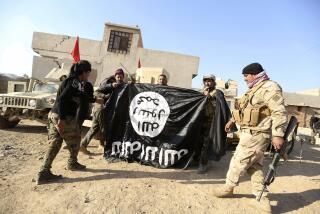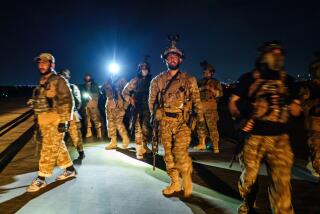Afghan Terror Network Is Still a Threat, U.S. Says
- Share via
BAGRAM AIR BASE, Afghanistan — Al Qaeda and the Taliban are on the run, but they retain a powerful network of arms, money and determined fighters that continues to compel U.S.-led anti- terrorism forces to prepare for further major offensives, the American commander of coalition troops said Friday.
That assessment by Army Maj. Gen. Frank L. Hagenbeck in an interview contrasted with the upbeat forecast of the top British officer here a day earlier, who proclaimed the campaign to eradicate terrorists from Afghanistan “all but won.”
“There’s still a lot of work to be done to get Al Qaeda and Taliban killed or captured, as a lot have been pushed into neighboring countries,” said Hagenbeck, who oversees the 17,000-strong coalition deployment in this country.
Smaller, more focused search-and-destroy operations have dominated the agenda in recent weeks, after the March execution of Operation Anaconda loosed the most fearsome firepower yet in the global battle against terrorism waged in the wake of the Sept. 11 attacks.
A Canadian-led mission, Operation Torii, wrapped up this week after combing the Tora Bora area, site of a major battle in December. The allied forces found human remains buried with honors but have yet to determine whether they belong to Osama bin Laden or other senior Al Qaeda operatives.
Operation Snipe, under British command, has scoured the mountains of Paktika province in the east for the last two weeks to locate and seize weapons cached by the terrorists.
But with Al Qaeda and the Taliban still capable of mounting suicide offensives and undermining the tentative stability recently achieved in Afghanistan, the coalition must remain at sufficient strength to mount Anaconda-level offensives if necessary, Hagenbeck said.
His outlook on the security and defense needs here reflected the views recently aired by Defense Secretary Donald H. Rumsfeld that much work remains to destroy enemy command and control networks.
But Brig. Roger Lane, who commands the 1,700 British troops based at Bagram, hinted that Operation Snipe was a cleanup mission and a prelude to bringing at least some of the troops home.
Canada, which has 850 soldiers in Afghanistan, has also been reviewing its deployment level with an eye to scaling back, now that politicians and taxpayers perceive that the shooting war seems to be over. Defense Minister Art Eggleton said Monday that maintaining current troop strength in Afghanistan beyond this summer would be “a challenge.”
The Pentagon, however, is far from ready to set an exit date and remains convinced that much needs to be done in the way of strengthening security and defeating extremism, Hagenbeck said.
Although most of the military activity underway now is aimed at preventing Al Qaeda and the Taliban from launching fresh assaults, the enemy remains active and influential in some areas, making it imperative that coalition forces avoid letting their guard down, said the general.
“We need to maintain capabilities to execute small-scale and large-scale missions,” he insisted.
U.S. air power has backed up both the Torii and Snipe missions, but most of the American activity lately has been directed at tracking suspected terrorists crossing into and out of Afghanistan along the largely unguarded border with Pakistan.
“We have the resources to determine when and how Al Qaeda or Taliban forces in neighboring countries try to reenter Afghanistan,” Hagenbeck said.
He added that their presence in the region constitutes a threat even if they are not physically in this country.
“I think we’ve hurt them. We do have them on the run. But they maintain command and control capacities and are working hard to recreate an environment in which they can train more soldiers,” he said, pointing to recent intelligence reports of Al Qaeda operatives showering villagers in targeted areas with money and other inducements for support.
Coalition civil affairs workers are waging their own hearts-and-minds campaign in volatile regions such as the lawless southeast, but Hagenbeck conceded that the fiercely independent tribes far from Kabul, the capital, are not going to be won over quickly.
Asked whether a CIA-ordered strike this week on a recalcitrant Afghan warlord, Gulbuddin Hekmatyar, could undermine popular support for the U.S.-led coalition forces in Afghanistan, Hagenbeck said he couldn’t discuss the work of “other agencies” but added that the military side is usually informed ahead of such actions.
The Monday missile attack from an unmanned Predator aircraft, which missed Hekmatyar, marked the first time in the Afghan operation that U.S. operatives targeted an enemy outside of the Al Qaeda and Taliban ranks.
Coalition forces are charged with aiding the interim government of Hamid Karzai and creating conditions that will help determine the future leadership of Afghanistan, he noted.
With Al Qaeda still armed, organized, in search of havens and new recruits, “we’re here till we’re done,” Hagenbeck said of the anti-terror effort.
More to Read
Sign up for Essential California
The most important California stories and recommendations in your inbox every morning.
You may occasionally receive promotional content from the Los Angeles Times.











